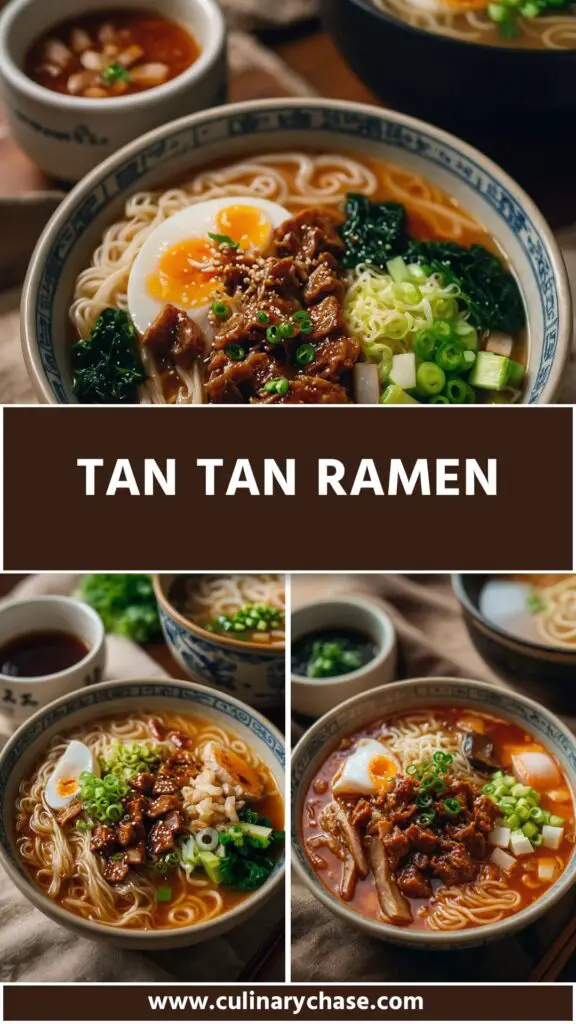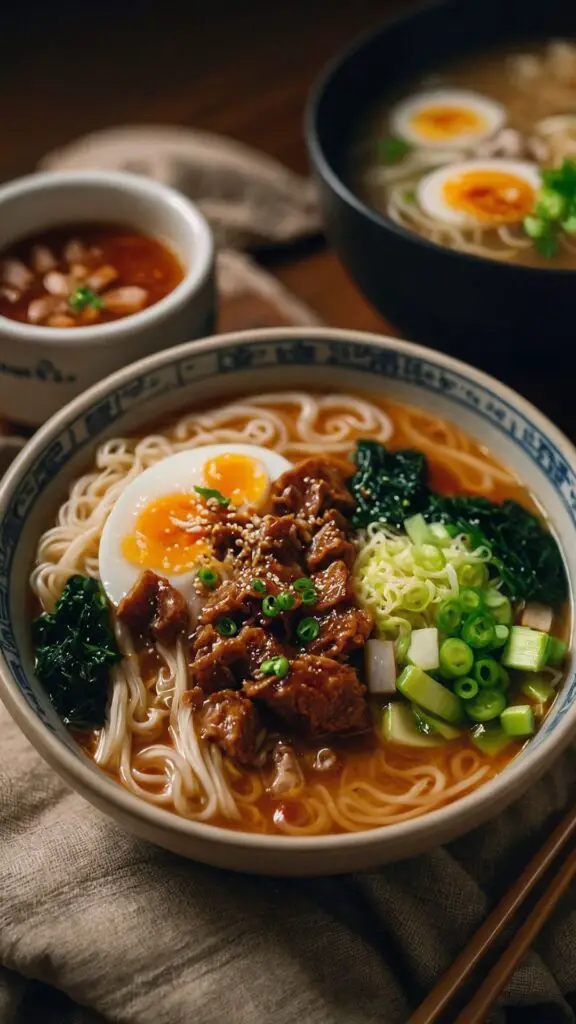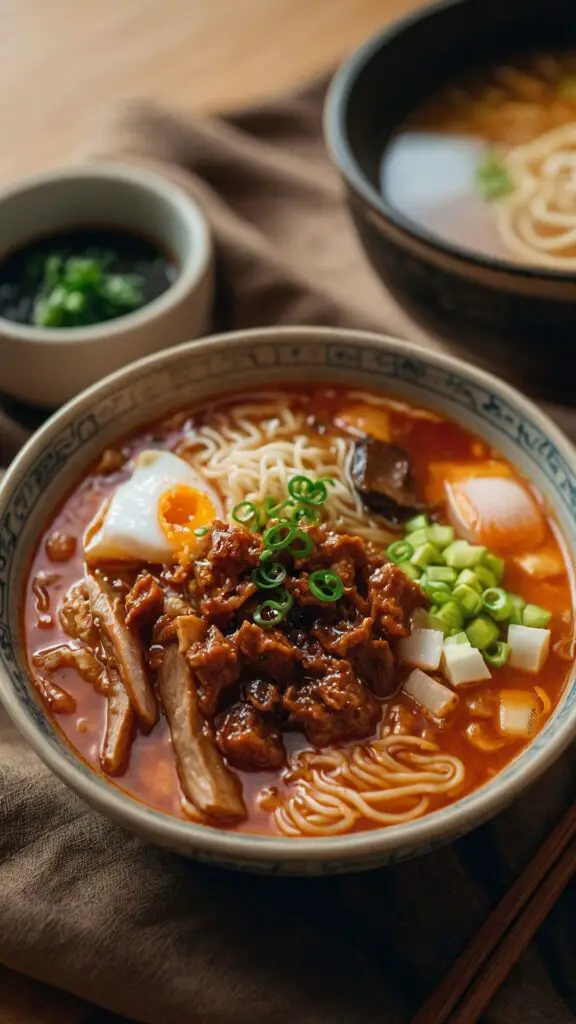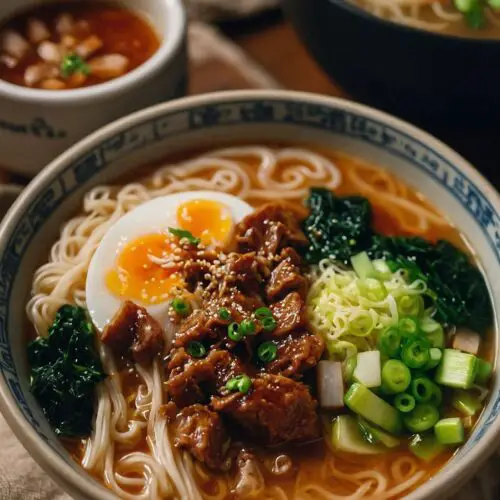Tan Tan Ramen – Culinary Chase
When you’re whipping up a quick Chicken Broccoli Mushroom Stir Fry, think about sides that bring additional flavor and texture. Cooked rice or noodles is a classic pairing. They soak up the savory sauce beautifully.
Next up, a fresh cucumber salad can provide a crunchy contrast, enhancing your meal with a bit of zing. For added nutrition, consider adding a serving of edamame on the side; they add a protein punch that complements the dish without overwhelming it.

My Love Affair with Tan Tan Ramen
I stumbled upon tan tan ramen during one of my culinary explorations. This delightful dish is not just food; it’s an experience. The first time I tasted it, I was captivated by the layers of flavor that danced on my palate.
The perfect balance of savory, nutty, and spicy notes left me wanting more. Each spoonful brought a warmth that soothed my soul. Since then, I’ve dedicated myself to mastering this dish, blending traditional recipes with my own touch.
Through my journey, I’ve delved deep into the origins and variations of tan tan ramen. It all began in the Sichuan region of China, evolving into the bowl we know today. Curious? Let’s unravel this deliciousness together.
What is Tan Tan Ramen?
Tan tan ramen is a rich and creamy noodle soup that features a delightful base of sesame and peanut flavors, complemented by ground meat, often pork. It bears roots in the Sichuan cuisine, where it was historically served with rice. Over time, it transformed into a beloved noodle dish, gaining popularity for its comforting and spicy profile.
It’s not just ramen. It’s a bowl filled with depth, history, and culture. I’ve come to appreciate how each chef adds their twist, making it a dish that continues to evolve while retaining its essence.
You will also like the following Dinner recipes!
- Taiwanese Beef Noodle Soup In Instant Pot
- Shrimp Lobster Sauce
- Copycat String Bean Chicken Recipe Stir Fry
What is the Flavor Profile of This Dish?
Every bite of tan tan ramen is an exploration. The first flavor you encounter is the nuttiness from sesame paste, which provides a creamy texture. This is soon followed by the savory notes from the ground pork, beautifully roasted and combined with a hint of chili oil that warms you from the inside out.
The layers don’t stop there. Each slurp of noodles brings forth a gentle heat lingering in the background. A dash of vinegar brightens the dish, cutting through the richness. You might even catch the fresh sharpness of scallions. It’s a dance of flavors, each element perfectly balanced while standing out on its own.
What Makes This Recipe Different from Other Tan Tan Ramen?
While many tan tan ramen recipes stick to traditional ingredients, I like to innovate. My version incorporates a more accessible set of ingredients, while still capturing the essence of the classic dish. Unlike some recipes that use heavy broth, I prefer a lighter, creamy base made with oat milk, which still retains that delicious mouthfeel without overwhelming richness.
Additionally, I’ve experimented with various leafy greens, bringing a fresh side to the dish that isn’t usually emphasized. Here, the leafy greens serve not just as garnish but integrate into the flavor profile, making each bowl not only delightful but also nourishing.
Ingredients You’ll Need
For the Pork & Marinade:
- 2 cloves garlic (minced)
- 1 tablespoon ginger (minced)
- 1 tablespoon spicy bean sauce (Sichuan doubanjiang)
- 1 tablespoon mirin
- 8 ounces ground pork (or substitute with chicken, turkey, or tofu for a vegetarian option)
- 1 tablespoon vegetable oil (or any other neutral oil)
For the Soup Base:
- 2 cups chicken stock (or vegetable broth for a vegetarian version)
- 1 tablespoon chili oil (preferably homemade for fresh flavor)
- 2 cups unsweetened oat milk or soy milk
- 2 tablespoons sesame paste (can substitute with peanut butter)
- 2 tablespoons soy sauce
- 1 teaspoon rice vinegar
- ½ teaspoon sugar
For the Noodles & Toppings:
- 2 scallions (finely chopped)
- 2 handfuls leafy greens (such as spinach, baby bok choy, or yu choy, trimmed and washed)
- 10–12 ounces fresh ramen noodles (such as Myojo medium-thick wavy ramen noodles)

Step by Step Directions
Step 1: Prepare the Pork Marinade
In a bowl, combine the minced garlic, ginger, spicy bean sauce, mirin, and ground pork. Mix it well and let this marinate for about 15–20 minutes. This allows the flavors to meld beautifully.
Step 2: Cook the Pork
Heat the vegetable oil in a pan over medium heat. Once hot, add the marinated pork. Cook it until browned and fully cooked, breaking it apart with a spatula to achieve a fine texture. This should take about 5–7 minutes. Set aside once cooked.
Step 3: Create the Soup Base
In a large pot, combine the chicken stock and bring it to a gentle simmer. Next, add chili oil, oat milk, sesame paste, soy sauce, rice vinegar, and sugar. Stir this mixture well. Allow it to simmer for dinner—around 10 minutes—so that the flavors unite.
Step 4: Prepare the Noodles
While the soup base simmers, boil water in a separate pot. Once boiling, cook the fresh ramen noodles according to package instructions, usually around 3–5 minutes. Drain and set aside when ready.
Step 5: Assemble Your Ramen Bowl
Now comes the fun part! In individual bowls, add a portion of noodles. Pour the rich soup base over the noodles liberally. Top with the cooked pork, chopped scallions, and a handful of leafy greens. For an extra kick, drizzle a bit more chili oil on top. Enjoy your piping hot bowl of tan tan ramen!
Tips on Making Tan Tan Ramen
- Use Fresh Ingredients: Fresh garlic and ginger enhance flavor significantly. They add a pungent kick that dried spices can’t match.
- Control the Heat: Adjust the level of chili oil based on your heat tolerance. A little goes a long way!
- Experiment with Broths: Try using homemade broth for a richer base. Alternatively, vegetable stock would work beautifully for a lighter option.
- Add Depth with Acidity: Incorporate a splash of vinegar or even a squeeze of lime before serving to brighten the dish.
- Tweak the Toppings: Don’t hesitate to experiment with toppings. Consider adding soft-boiled eggs or seaweed for an extra layer of flavor.
Nutrition Information
Serving size: About 1 bowl
- Calories: 580
- Protein: 25g
- Carbohydrates: 65g
- Fat: 25g
- Fiber: 4g
This dish is nutrient-rich, providing a balance of protein and carbs. Leafy greens add vitamins and minerals, making it a wholesome choice.
How Can I Store This Tan Tan Ramen?
If you find yourself with leftovers (though I doubt you will!), store the components separately in airtight containers. The noodles can become mushy if left in the broth. Refrigerate for up to three days. Reheat gently on the stove, adding a splash of broth or water to retain moisture.

Substitute Options for Ingredients
- Ground Meat Alternatives: Try ground turkey or chicken if you’re looking for a leaner option. Tofu is an excellent substitute for vegetarian or vegan preferences, offering the same satisfying texture.
- Liquid Alternatives: Substitute chicken stock with vegetable broth for a vegetarian-friendly version. Alternatively, bone broth can add depth of flavor.
- Noodle Options: Use gluten-free noodles if you have dietary restrictions. Rice noodles or gluten-free ramen can serve as excellent alternatives.
- Nut Alternatives: Sunflower seed butter can replace sesame paste for a nut-free option while still providing that rich, creamy texture.

Tan Tan Ramen
Equipment
- Pot
- Bowl
Ingredients
For the Pork & Marinade:
- 2 cloves garlic minced
- 1 tablespoon ginger minced
- 1 tablespoon spicy bean sauce Sichuan doubanjiang
- 1 tablespoon mirin
- 8 ounces ground pork or substitute with chicken, turkey, or tofu for a vegetarian option
- 1 tablespoon vegetable oil or any other neutral oil
For the Soup Base:
- 2 cups chicken stock or vegetable broth for a vegetarian version
- 1 tablespoon chili oil preferably homemade for fresh flavor
- 2 cups unsweetened oat milk or soy milk
- 2 tablespoons sesame paste can substitute with peanut butter
- 2 tablespoons soy sauce
- 1 teaspoon rice vinegar
- ½ teaspoon sugar
For the Noodles & Toppings:
- 2 scallions finely chopped
- 2 handfuls leafy greens such as spinach, baby bok choy, or yu choy, trimmed and washed
- 10 –12 ounces fresh ramen noodles such as Myojo medium-thick wavy ramen noodles
Instructions
Step 1: Prepare the Pork Marinade
- In a bowl, combine the minced garlic, ginger, spicy bean sauce, mirin, and ground pork. Mix it well and let this marinate for about 15–20 minutes. This allows the flavors to meld beautifully.
Step 2: Cook the Pork
- Heat the vegetable oil in a pan over medium heat. Once hot, add the marinated pork. Cook it until browned and fully cooked, breaking it apart with a spatula to achieve a fine texture. This should take about 5–7 minutes. Set aside once cooked.
Step 3: Create the Soup Base
- In a large pot, combine the chicken stock and bring it to a gentle simmer. Next, add chili oil, oat milk, sesame paste, soy sauce, rice vinegar, and sugar. Stir this mixture well. Allow it to simmer for dinner—around 10 minutes—so that the flavors unite.
Step 4: Prepare the Noodles
- While the soup base simmers, boil water in a separate pot. Once boiling, cook the fresh ramen noodles according to package instructions, usually around 3–5 minutes. Drain and set aside when ready.
Step 5: Assemble Your Ramen Bowl
- Now comes the fun part! In individual bowls, add a portion of noodles. Pour the rich soup base over the noodles liberally. Top with the cooked pork, chopped scallions, and a handful of leafy greens. For an extra kick, drizzle a bit more chili oil on top. Enjoy your piping hot bowl of tan tan ramen!
Notes
- Use Fresh Ingredients: Fresh garlic and ginger enhance flavor significantly. They add a pungent kick that dried spices can’t match.
- Control the Heat: Adjust the level of chili oil based on your heat tolerance. A little goes a long way!
- Experiment with Broths: Try using homemade broth for a richer base. Alternatively, vegetable stock would work beautifully for a lighter option.
- Add Depth with Acidity: Incorporate a splash of vinegar or even a squeeze of lime before serving to brighten the dish.
- Tweak the Toppings: Don’t hesitate to experiment with toppings. Consider adding soft-boiled eggs or seaweed for an extra layer of flavor.
Nutrition
Frequently Asked Questions
1. Can I make tan tan ramen vegetarian?
Absolutely! Use vegetable broth, substitute ground meat with tofu or mushrooms, and omit meat-based sauces
2. How spicy is tan tan ramen?
The spiciness largely depends on the chili oil used. You can control the heat level by adjusting the amount of chili oil or using a milder variant.
3. What if I can’t find Sichuan doubanjiang?
You can use a combination of soy sauce and a bit of Sriracha for a similar flavor profile that adds both saltiness and heat.
4. Can I store tan tan ramen?
Yes, but keep the components (noodles, broth, and toppings) separate for optimal freshness.
5. What kind of greens can I use?
You can use any leafy greens you prefer! Spinach, bok choy, or even kale work well in this recipe adding nutritious benefits.
Conclusion
Tan tan ramen is more than just a dish; it’s a delightful way to infuse warmth and flavor into your culinary routine. This recipe marries tradition with a modern touch that makes it accessible and fun to create. Whether you’re enjoying this solo or sharing it with loved ones, each bowl promises comfort and satisfaction. So, grab those ingredients and dive into the delicious world of tan tan ramen. Trust me; your taste buds will thank you!
